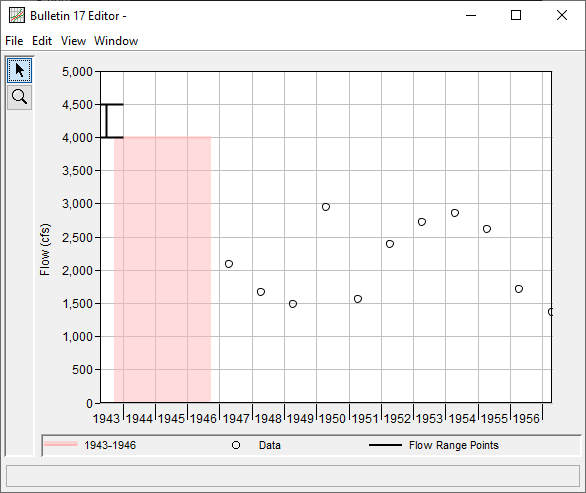Download PDF
Download page Overview.
Overview
Background
There are two general types of observations or measurements used in statistical analysis. The first type is an exact observation which means the measurement has no uncertainty. Sometimes the measurement is truly exact and sometimes the measurement is assumed to be exact. Systematic flow data is typically assumed to be an exact measurement even though all flow measurements are uncertain to some extent. The uncertainty in systematic flow data is typically assumed to be small enough that it can be ignored. The second type is a censored observation which means the measurement has uncertainty. The uncertainty in a non-systematic flow estimate is typically too large to ignore.
There are three general types of censored measurements. The first type of censored data is left censored which means that the observation is known to be less than some value. A perception threshold is an example of left censored data. The second type of censored data is interval censored data which means the that observation is known to be between two values. A flow interval is an example of interval censored data. The third type of censored data is right censored which means that the observation is known to be greater than some value. A perception threshold can also be right censored data, but this is uncommon.
https://en.wikipedia.org/wiki/Censoring_(statistics)
Bulletin 17C (B17C) made three significant improvements in flow frequency analysis methods. First, the Expected Moments Algorithm (EMA) makes use of exact and censored flow data. In other words, EMA does a better job of using uncertain historic flow estimates. Previous methods used in Bulletin 17B (B17B) were limited which means that historic information could not be used effectively. Second, the confidence intervals are more accurate using B17C mostly because the uncertainty in skew is included in the analysis. Previous methods used in B17B assumed a normal approximation for the confidence intervals that ignores the uncertainty in skew resulting in a narrower confidence interval. Third, the low-outlier procedure in B17C can identify and treat multiple potentially influential low floods (PILF). Previous methods used in B17B would most often identify and treat one low outlier, when necessary.
EMA can utilize three types of at-site flood information.
- Systematic (Exact)
- Historic (Interval Censored)
- Perception Thresholds (Left or Right Censored)
EMA can also utilize regional skew information.
EMA uses an iterative procedure to compute method of moments parameter estimates (i.e. mean, standard deviation, and skew) for a Log Pearson Type 3 (LP3) distribution. Initial parameter estimates are calculated for the exact (systematic) data. The parameter estimates are used to estimate the expected moments for the interval censored (historic) and left censored (perception threshold) data. The exact (systematic) data is then combined with the expected moments to update the parameter estimates. The process is repeated until the parameter estimates converge.
Here are links to Bulletin 17C and Bulletin 17B.
https://pubs.er.usgs.gov/publication/tm4B5
https://water.usgs.gov/osw/bulletin17b/dl_flow.pdf
Exercise
Given the Perception Thresholds within Table 1 and the Flow Ranges shown in Table 2, perform a B17C analysis using HEC-SSP.
Table 1. Perception Thresholds
Start Year | End Year | Low Threshold (cfs) | High Threshold (cfs) | Comments |
|---|---|---|---|---|
1943 | 1957 | 0 | inf | Total Record |
1944 | 1946 | 4000 | inf | 1943 Flood |
Table 2. Flow Ranges
| Water Year | Peak (cfs) | Low Value (cfs) | High Value (cfs) | Data Type |
|---|---|---|---|---|
| 1943 | 4250 | 4000 | 4500 | Historical |
| 1944 | - | 0 | 4000 | Censored |
| 1945 | - | 0 | 4000 | Censored |
| 1946 | - | 0 | 4000 | Censored |
| 1947 | 2080 | 2080 | 2080 | Systematic |
| 1948 | 1670 | 1670 | 1670 | Systematic |
| 1949 | 1480 | 1480 | 1480 | Systematic |
| 1950 | 2940 | 2940 | 2940 | Systematic |
| 1951 | 1560 | 1560 | 1560 | Systematic |
| 1952 | 2380 | 2380 | 2380 | Systematic |
| 1953 | 2720 | 2720 | 2720 | Systematic |
| 1954 | 2860 | 2860 | 2860 | Systematic |
| 1955 | 2620 | 2620 | 2620 | Systematic |
| 1956 | 1710 | 1710 | 1710 | Systematic |
| 1957 | 1370 | 1370 | 1370 | Systematic |
The EMA Data should resemble Figure 1.

Compute the analysis and answer the following question.
Question 1. What are the mean, std dev, and skew of the fitted LP3 distribution?
Mean (log) = 3.335, Std Dev (log) = 0.145, Skew (log) = 0.127.